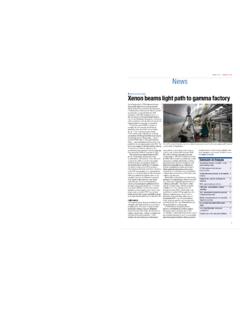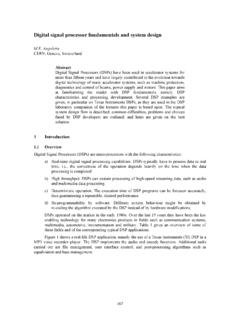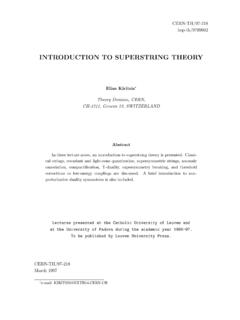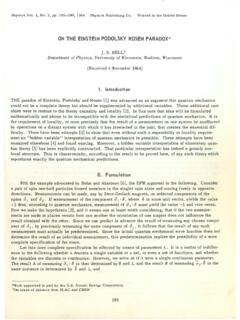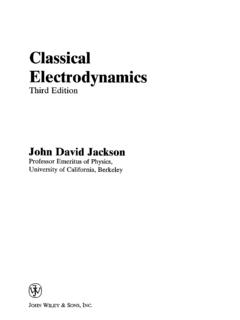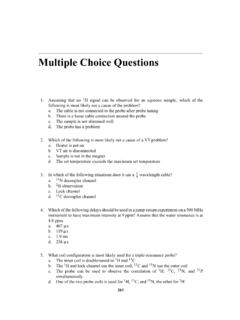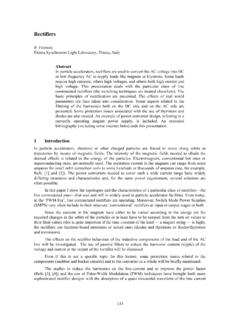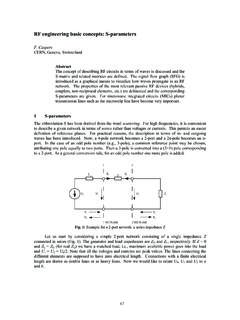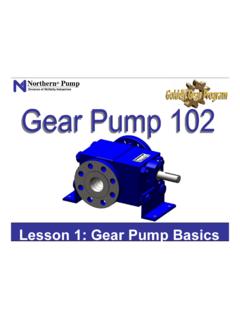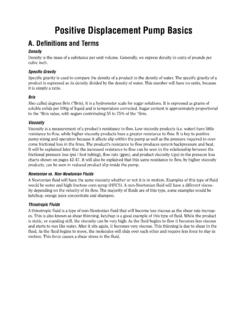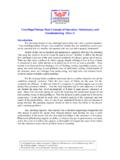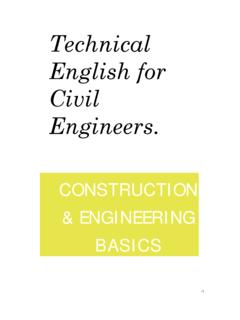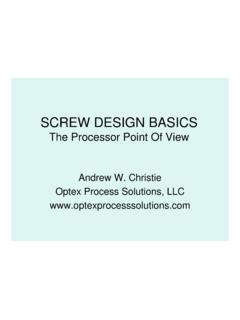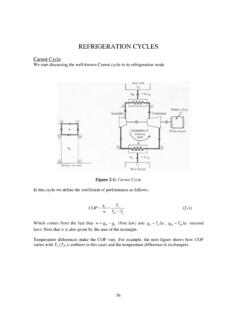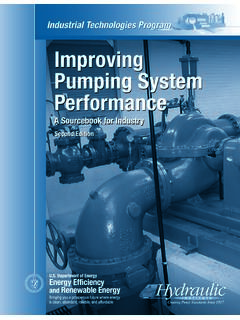Transcription of Basics and applications of cryopumps - CERN
1 Basics and applications of cryopumps C. Day Forschungszentrum Karlsruhe, Institute of Technical Physics, 76344 Eggenstein-Leopoldshafen, Germany Abstract This report introduces the wide field of cryogenic pumping, from commercial cryogen-free refrigerator cryopumps to very special, tailor-made cryopumps . It starts with a short historic overview of the field of cryopumping. Then, the principles of cryogenic pumping via sublimation/condensation and physisorption are introduced, and we illustrate how they are exploited to derive a design for a usable cryopump. In the third part, typical characteristics of cryosorption pumps are discussed.
2 The report finishes with a few examples of applications . 1 Introduction This report is aimed at giving a general overview of cryopumping. Usually, the cooled surface is at least partly covered with a porous sorbent material. The design of a cryopump has to combine cryogenic aspects and technological vacuum considerations in a unique manner, as the generation of low temperature itself presupposes the existence of vacuum conditions and vice versa. Thus, the cryopump is by its physical principle a high-vacuum pump. Besides straightforward parameters, such as pressure and temperature, the performance cryopump is very much governed by the complex interaction between gas particles and cooled sorbent surface, which will be discussed in detail in this report.
3 The cryopump is the pump type that provides the highest pumping speeds, especially when operated in situ of the vacuum recipient. The present report contains an extensive list of references, a mixture of textbooks and specialized articles, to provide the reader with the opportunity to pursue any further details he might be interested in. 2 History of cryopumping Not surprisingly, the development of cryopumping went in parallel with the advances made in liquefaction (liquid nitrogen, K, Dewar, 1874; liquid hydrogen K, Dewar, 1898; liquid helium, K, Kammerlingh Onnes, 1908). It was soon found that vacuum can be produced by charcoal kept at these cryogenic temperatures.
4 The successful use of liquid-nitrogen-cooled traps to prevent oil backstreaming from diffusion pumps was reported in the 1910s by Gaede and Langmuir. However, the first large-scale applications of cryopumping were triggered by the first space projects in the 1950s. They often included operation with liquid hydrogen. In the second half of the last century, liquid helium bath-cooled cryopumps were very popular for laboratory applications , when oil contamination was requested (so that diffusion pumps could not be used) and manual re-fill was not a problem. The next big step forward was the development of cryogen-free regenerative refrigerators by Gifford and McMahon in 1960.
5 These devices have seen a significant progress towards higher cooling power at lower end temperatures, and their development continues. 241 Nowadays, Gifford McMahon cooled cryopumps are the high-vacuum pump of choice in many industrial processes, such as the semiconductor industries, especially in the USA. The company CTI-Cryogenics (now with Brooks Automation Inc.) is the leading global cryopump manufacturer. In Europe, turbomolecular pumps have widely replaced cryopumps in vacuum process plants. 3 Cryopumping fundamentals By international classification, a cryopump is defined as a vacuum pump which captures the gas by surfaces cooled to temperatures below 120 K [1].
6 To achieve vacuum in a closed volume means, simply speaking, to remove all molecules in the gaseous phase within this volume. According to the different physical principles, which are exploited to create, improve or maintain vacuum, there are different types: Positive displacement or mechanical pumps, which provide volumes to be filled with the gas being pumped. The volumes are cyclically isolated from the inlet, the gas is then transferred to the outlet. In most types of positive displacement vacuum pumps the gas is compressed to atmosphere before the discharge at the outlet. Positive displacement pumps work independently of the gas species to be pumped.
7 Kinetic pumps, which impart momentum to the gas being pumped in such a way that the gas is transferred continuously from the pump inlet to the outlet. Entrapment or capture vacuum pumps, which retain gas molecules by chemical or physical interaction on their internal surfaces. Together with the getter and the sputter ion pump, the cryopump is the most prominent representative of the latter group. As for all high vacuum pumps ( , pumps working below the 10 3 Pa range) an appropriate medium forepressure has to be provided by a mechanical forepump, before the cryopump can be started. The forepump is also needed to exhaust the gas to the atmosphere.
8 Whereas this gas transfer is done continuously in the case of kinetic and positive displacement pumps, entrapment pumps do this in a batch-wise manner as they accumulate the gas during pumping and must be regenerated from time to time. During actual pumping, the gases within the entrapment pump systems are instantaneously immobilized and no outlet is required at all. Cryopumping mechanisms The cryopumping effect is produced by intimate interaction between the gas particles to be pumped and a cold surface provided to them in the cryopump. The forces involved are relatively weak (primarily van der Waals dispersion type) and do not include chemical bonds, as is the case for chemisorption with the chemically active alloys in getter pumps.
9 Consequently, cryopumps do not require such high temperatures for regeneration. cryopumps can pump all gases including noble gas, if the temperature is sufficiently low. The amount of molecules that can be accumulated depends on a number of physical factors such as temperature of gas and surface, physicochemical properties of gas and surface (surface energy distribution), microscopic roughness of the surface, etc. The different categories are treated in the following sections. Cryocondensation In this case, the surfaces must be cooled to such a temperature as to keep the corresponding saturation pressure equal to or below the desired vacuum pressure in the chamber.
10 The achievable pressure is determined by the saturation pressure at the temperature chosen for the cold surfaces. This principle is the most elementary of all forms of capture pumping. For many gases, the pressure range of C. DAY242cryopumps is below the triple point pressure of the individual gases to be pumped. Thus, the relevant saturation curve becomes identical with the sublimation curve, , during pumping, the gas particles undergo direct phase transition from the gaseous to the solid phase without any liquid phase. Within this report, as is customary in cryopumping, the term condensation is used for both types of transition out of the gaseous phase, and combines re-sublimation (gaseous solid) and condensation (gaseous liquid).
